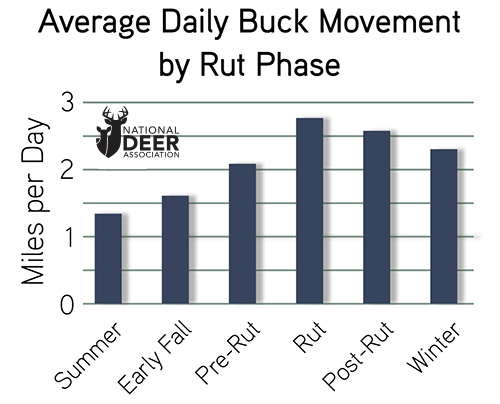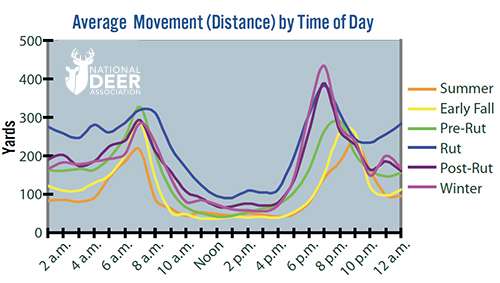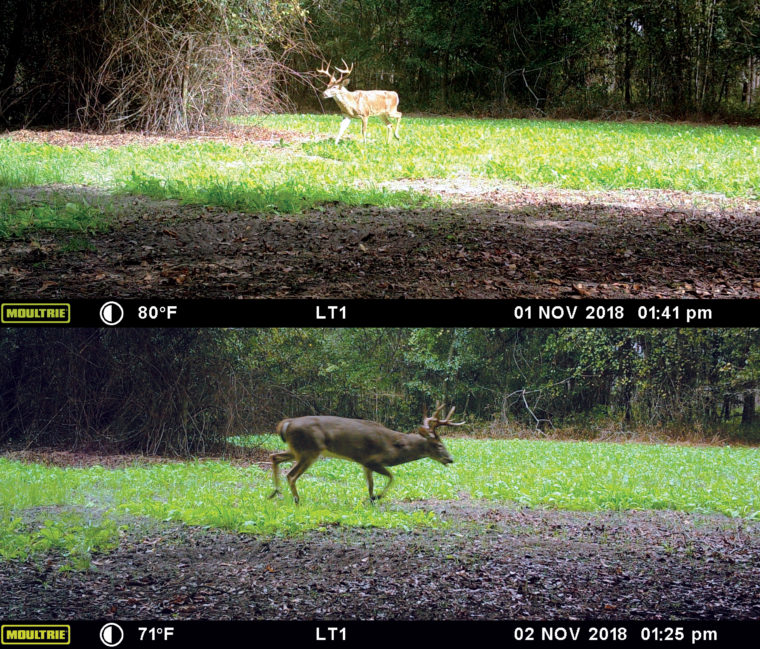7 antlered bucks at one time. That’s what I was watching on the afternoon of November 17, 2018. One by one they entered a large food plot from different directions, all of them yearlings to 3½-year-olds, and fed and sparred with each other for almost an hour as I watched, fascinated. I’ve seen that many unique bucks before in the course of a hunt but never that many all at once.
Thinking this particular field must be some mysterious deer-activity hub, I returned before light the next morning, excited about what new wonders I might witness. But in over three hours of hunting that morning, not a single deer came to feed in the plot.
This is deer hunting. Just when you think you’ve got it figured out, whitetails will prove you wrong. I have theories about which factors explained why I saw all those bucks at one time, but many of those same factors were still in place the next morning. Rut conditions were still the same, and so was the weather. The food plot was still full of attractive forages. I still had the wind in my favor.
Many of these important variables are highly local and independent of planetary cycles. No salesman, weather forecast or lunar calendar can solve the equation for you.
When I think back to these and many other examples of deer evading predictability and wonder how they did it, all I can do is shrug. But this lack of understanding, this lack of any ability to consistently foretell deer movements, drives us to solve the mystery. It’s time we stopped, because there is no simple solution.
When hunters believe there could be a single key that will unlock the mystery of deer movement, it makes them susceptible to salesmen and their products. We are easily seduced by short-cuts that promise to tell us when to go hunting. Solunar tables and their “major feeding times” are extremely popular and addictive despite being based on century-old ideas about fish behavior. Magazine covers that promise the buyer exclusive rut predictions fly off the newsstand. Apps for predicting wildlife movement are downloaded by the thousands. Even the theory that cold fronts increase deer movement is accepted by many because it makes predicting deer behavior simple: Just watch your local weather forecast to know when to go hunting and when not to.
The fact is many variables and even random chance swirl together in strange ways to produce the outcome you desire – seeing lots of deer and killing the ones you want to kill. Many of these important variables are highly local and independent of planetary cycles. No salesman, weather forecast or lunar calendar can solve the equation for you.
Here’s the good news. By studying the reliable science behind these factors and aligning as many of them as you can in your favor each time you go hunting, you increase your odds of success.
Please note I didn’t say “guarantee” success. Failure is still an option, and it always will be.
As a journalist, I’ve spent nearly two decades reporting on deer research. I’m going to list the factors identified by science that play significant roles in deer movement (Spoiler Alert: weather is not among them). Think of each of these local factors as one dial in a combination lock, then spin each dial to reveal the sequence for any given day that will put you in a likely position for success. It’s a procedure for solving a problem. In a word, an algorithm.
Deer Food
This is simple: Be where the best food is. That word best is critical. Many’s the time I’ve known hunters to sit proudly but disappointedly over their beautiful green food plots while white oak acorns are falling somewhere else. In a taste-test like that, I don’t care what the temperature is or what the major feeding times are, more deer are going to be found beneath the white oaks. Science has noted a link between white oak crops and deer harvest: When white oaks have a great year, deer harvest slumps because deer movements are not concentrated around more limited food sources.
Dr. Bronson Strickland of Mississippi State University emphasized that deer must eat every day, regardless of weather, moon phase or the positions of any planets. When you hunt near a food source and don’t see deer, they’re probably eating something else.
At any given point in deer season, these comparisons are going on. Deer foods of certain types are available while foods of other types are preferred. Conditions can change in a flash as the preferred option plays out or a new option appears. For example, when the white oak acorns are finally consumed, the deer may turn their hungry attention to that food plot now. A food plot of radishes might be passed up for a plot of cereal grains until the first hard frost awakens the sugars in the radish greens, and then the preference reverses overnight. In any given location and time, it’s a question of what else the deer could be eating.
These patterns don’t always hold across seasons. A drought might reduce natural forage availability one year, making food plots more attractive than normal. An acorn failure in white oaks might make a stand of red oaks the place to be when they were a ghost town last year.
How important is the food factor? In a Down South Hunting podcast episode focused on weather research, Dr. Bronson Strickland of Mississippi State University emphasized that deer must eat every day, regardless of weather, moon phase or the positions of any planets. When you hunt near a food source and don’t see deer, they’re probably eating something else. It’s up to you to scout and learn what that is.
Stage of the Rut
Study on top of scientific study has reinforced a basic concept about buck movement: Bucks steadily increase their average daily movements right up to the peak of breeding, after which it slowly declines again to its summer low point. You stand a better chance of seeing bucks around the time of peak breeding than you do in the pre- or post-rut because they are naturally moving more.
I’ve often wondered if this fact led us by accident to our strong faith in cold fronts. In most of the United States, rut activity peaks in November, which is generally colder than October, which is generally colder than September. Is this how hunters came to believe cold drives deer movement? By a coincidence of timing? When scientists have looked at weather as a driver of movement independent of other factors like the rut, they’ve found almost no support for a relationship, to the enduring surprise of most deer hunters.

This chart from a Maryland study of GPS-collared bucks reflects patterns seen in many other studies as well: daily buck movement increases up to the peak of breeding and then declines again.
Rut peaks vary all over the map of North America, so regardless of the exact calendar date of your local rut peak, expect buck movement to peak then. They travel further and cover a greater percentage of their home ranges around this time than any other.
University of Georgia researcher Michael Biggerstaff set up one trail-camera per 50 acres on 2,500 acres of hunting land (yes, 50 cameras) and ran them for a calendar year on major deer trails. Of an entire year’s adult buck photos, 61% of them were taken in a one-month period around the peak of breeding! During this peak of buck movements, Michael did not see a significant relationship with weather patterns. Also, buck photos were primarily taken around dawn and dusk (more on time-of-day later).
Some bucks may linger in one place around an estrus doe at intervals during this time, but your chances of seeing a buck moving are still better now than they were before the rut became a factor.
Of course, if you only have eyes for one specific buck, his wide-ranging movements at this time will be detrimental to your efforts to meet him. Research has shown average home-range sizes for adult bucks of 350 acres (South Carolina) and 900 acres (Pennsylvania) in heavily forested regions to over 1,000 acres in more open country. Crossing paths with a buck that is bouncing around an area that large is a challenge. On the plus side, the peak of breeding is often your only shot at seeing certain mature bucks moving in daylight.
The science about peak buck movement rates is reliable – no matter what you’ve heard about a lull or a “lock-down phase.” There is no distinct “phase” of the rut where all bucks stop moving and you have less chance of seeing one. Yes, an individual buck may spend several hours tending an individual doe when she’s almost receptive, but this doesn’t happen all in a single phase or to all bucks and does at once. Remember that studies following GPS-collared bucks show peak daily movement rates by bucks as a group occurring at the peak of breeding – meaning most bucks are still covering a lot of ground. Some of them may linger in one place around an estrus doe at intervals during this time, but your chances of seeing a buck moving are still better now than they were before the rut became a factor.
Hunting Pressure
More than any other factor in the matrix of deer movement, this is the one that is most in your control. It’s also unique in that it acts as a damper on all other positive factors. Food sources, rut activity – everything might be lining up in your favor, but if you mis-manage hunting pressure, you dispel the mojo.
If you are predictable in your hunting patterns, adult bucks will own you.
Multiple studies of buck movements in hunted scenarios show deer actively learn and avoid locations or times of greatest hunting pressure. When he was at Auburn University and tracking GPS-collared bucks, Clint McCoy found bucks were attracted to stand sites with food plots and feeders, but attraction immediately switched to avoidance the day after a stand was hunted, and the tendency to avoid that stand site lasted on average for three days after the hunt before bucks were seen to be attracted to the site again.
If you are predictable in your hunting patterns, adult bucks will own you. They’ll know the stands you frequent or even the days of the week you are mostly likely to show up. Another former Auburn student, Kevyn Wiskirchen, in a different study on four properties, two of which were WMAs, found a clear link between deer activity and high hunting pressure on weekends. The highest level of daylight deer activity throughout hunting season was on Thursdays.
Think like a deer. Knowing yourself and any hunters who share your hunting area, could you make a prediction about where everyone will be hunting this weekend? If so, then deer have enough information to make the same prediction. Go where they would go. Change things up and choose a new area of low pressure to try.
Time of Day
Deer are crepuscular animals, active most at dawn and dusk. Numerous movement studies confirm this. Repeatedly, in all regions of the country, in all seasons, and even in all moon phases, deer wearing GPS tracking collars are most active around dawn and dusk. On average, night is the second most active period. Mid-day is the lowest activity period.
This is not to say you can’t see deer at mid-day on an all-day sit. You can. You might even sit all day and see the only deer all day long at 1 p.m. in broad daylight. This is called anecdotal evidence, which does not indicate a reliable pattern. Odds are, based on averages established in science, deer in your vicinity were most active around dawn and dusk.

Time-of-day movements for 18 adult bucks tracked by North Carolina State University researchers. Like other studies, they found dawn and dusk were the daily peaks of buck movement in all seasons, rut phases and – yes – moon phases.
A few exceptions have been noted in some studies, such as does with young fawns adjusting their activity schedules to avoid peak coyote activity, and adult bucks and does moving more at mid-day in the presence of a large nocturnal predator like the Florida panther. But the overwhelming evidence from settings and seasons in which most deer hunters operate shows the early and late hours of any day being a hunter’s best opportunity to see deer.
Herd Density & Demographics
The first four factors listed above are most important, but I think it’s worth adding: You can’t see deer that don’t exist. Whether a result of a major EHD outbreak, overharvest of does in the past, deterioration of habitat quality or other reasons, if deer density is low in the area you hunt, it will be more difficult to locate and see deer, and you won’t be able to blame the moon, the weather or the “major feeding times.” If the oldest buck within miles of your hunting area is 3½, and you’re holding out for a 5½-year-old, be sure to pack plenty of snacks.
Your trail-cameras can help you gain realistic expectations for what’s in the area, and a formal trail-camera survey can even help you estimate density, buck:doe ratio and age structure. Or, a phone call to the deer biologist responsible for the county you hunt can help you gain a professional perspective on deer abundance and herd demographics.

Lindsay’s wireless trail-camera captured this buck crossing a food plot between 1 and 2 p.m. on two consecutive days in November 2018. Lindsay hunted this site during the mid-day hours on the third day, but the buck didn’t show. Even when we think we’ve got them patterned, adult bucks remain unpredictable.
A Science-Based Solution
In 2018, I thought I had a buck patterned. As the photos and caption above explain, it didn’t work out, and I’ll never know why. Later on in December, I was fortunate to kill a mature buck that no one I hunt with had ever seen before. But even when I killed that buck, I was sitting in a location I chose based on local food information, previous pressure patterns, the day’s wind direction, and knowing the rut was over and bucks would be hungry.
Aligning the most important factors in deer movement is not guaranteed to work every time. I’ve done it many times before without killing a buck. That’s the mystique of deer hunting – we will never solve this puzzle without cheating. But never let anyone tell you it’s not a good day to go to the woods because of the weather, the moon, tea leaves, or what the cows in Pawpaw’s pasture are doing. Get in the woods if you can go, but look for guidance in local information:
Food + Stage of the Rut + Hunting Pressure + Time of Day.
Let this sequence lead you to the best place and time to see deer!
